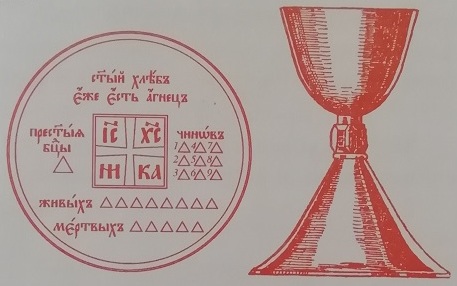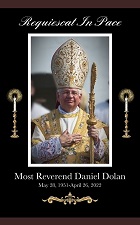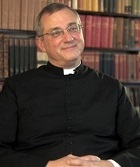The Blessed Virgin Mary in the Divine Liturgy
Question by a follower of the “hidden pope” cult:
"Schismatics, basing their faith on the lies of Martin Luther ignore the highly esteemed role of our Holy Mother as co-redemptrix, mediatrix and advocate and attempt to ignore her in every aspect of Catholic discussion. And by the many discussions we have had sir you fit within that category.
Answer the question. Why are you so quiet on the subject of the Blessed Virgin Mary and her very powerful role? Even the separated orthodox churches of the east hold the Blessed Virgin in very high esteem. We as true Catholics cannot talk about our Holy Lord in isolation of the Blessed Virgin Mary and vice versa as their two hearts are conjoined.
Only in the sacrifice of the Holy Mass in the Eucharistic prayer is the focus only on the Lord and the shedding of his blood for us."
Answer:
Well, in the beginning, let me tell you what the Catholic Church teaches on the importance of the Holy Mass (Divine Liturgy).
The Divine Liturgy is the Sacrifice of the New Testament, in which Christ, through the ministry of His priests, offers Himself to God the Father in an unbloody manner under appearances of bread and wine to perpetuate the Sacrifice of the Cross and to apply to men His own merits.
During the celebration of the Divine Liturgy the Sacrifice of the Cross is mystically represented and renewed on the altar and the fruits of the Sacrifice of the Cross are bestowed on those who attend it with a living faith.
The Sacrifice of the Cross and its mystical renewal at the Divine Liturgy is the tree of life for Christians, since it imparts the fullness of heavenly and imperishable life to all who duly take part in it (being in a state of the sanctifying grace).
When we assist at the Divine Liturgy, we stand at the foot of the Cross (the altar) upon which Christ renews His death for our salvation.
In the Eucharistic Sacrifice of the Divine Liturgy Jesus Christ does not only present to His Father a precious sacrificial gift (His Body and His Blood under the species of bread and wine), but He is also the most eminently pleasing High Priest. It is not the priest that primarily offers the Body and the Blood of Jesus to God. Jesus Himself is the principal PRIEST. Human priests are only His secondary ministers in offering to God the Sacrifice of the Divine Liturgy.
The Body and the Blood of Jesus is the richest and the most glorious, the most pleasing gift to God, for the Body and the Blood of the God-Man Jesus is incomparably more noble and valuable than all other human gifts. Therefore the Sacrifice of the Divine Liturgy has an infinite value in the eyes of God.
At the same time, neither Catholic priests nor laymen can be in separation from the Most Pure Mother of God.
Catholics honor and love the Blessed Virgin Mary since apostolic times. Devotion to the Mother of Savior is almost a distinctive characteristic of Catholics. We would question the Catholicism of those Catholics who do not venerate the Blessed Virgin Mary.
However, not every devotion is a real devotion. Not every devotee is a true child of Mary. A real devotion is a strong resolution of man’s will and a certain promptitude of his heart to serve the Blessed Virgin Mary by doing everything that pleases Her and by avoiding things which may displease Her.
From the following excerpts from the Divine Liturgy you can see that the Catholic priest of the Byzantine Rite stands at the foot of the Cross of Our Redeemer during the Holy Mass, in unity with the Blessed Virgin Mary, all the Angels and all the Saints. During the Divine Liturgy the priest encourages the faithful to give thanks to the Blessed Virgin for having given us Christ, without Whom the Sacrifice of the Divine Liturgy would be impossible.
All Catholic priests of the Latin Rite do the same. I hope if you take Missale Romanum and see how many prayers there are to the Blessed Virgin Mary, you will no longer say what you are saying now.
Fr. Valerii
The Marian excerpts from the Divine Liturgy of Saint John Chrysostom:
PROSKOMEDIA
The Liturgy (Mass) of the Ukrainian Rite (the Byzantine-Slavonic rite - Fr. Valerii's explanation) is composed of three principal parts (Proskomedia, The Liturgy of the Catechumens and The Liturgy of the Faithful) which represent the three periods of the life of Our Savior.
Proskomedia, or preparation, is the first part of the Ukrainian Rite Mass. The priest performs the proskomedia apart from the main altar, i.e., little side altar to remind the people that Our Lord was born outside the city of Bethlehem.
During the Proskomedia the priest prepares the bread and wine for the Sacrifice. The paten and chalice represent the crib; the star over the Holy Gifts recalls the star of Bethlehem, the large Ahnets represents Jesus Christ, the Victim, the larger host on the right side of the Ahnets, the Blessed Virgin Mary; the small hosts on the left side, the shepherds and the angels who came to adore the newly-born Messias.
Beneath the large Host, a few small hosts are placed to represent the faithful, living and dead. Thus the whole Church is represented and gathered around Christ.

The veils wherewith the Holy Gifts are covered, remind us of the swaddling-clothes with which the Blessed Virgin covered her Son in the manger.
The priest takes another prosphora. If there is but one altar-bread, prosphora, the priest performs all functions upon the one prosphora. Keeping the prosphora in his hand, he says:
In honor and commemoration of Our Most Blessed Lady, the Mother of God and ever-virgin Mary, through whose prayers accept, O Lord, this sacrifice on Thy heavenly altar.
The priest takes a particle of the bread and lays it on the right side of the Ahnets (Lamb). This particle represents the Blessed Virgin Mary at the crib of the Lord when He was born in the grotto at Bethlehem.
Placing this particle in honor of the Mother of God on the right side of the Ahnets, which represents Jesus, the priest says:
At Thy right hand stood the queen, clothed in a golden garment wrought with varied colors.
Priest (says the dismissal):
May He Who rose again from the dead, Christ, Our True God, through the prayers of His Most Pure Mother, of our Father among the Saints, John Chrysostom, the Archbishop of Constantinople, and of all the Saints, have mercy upon us, and save us, for He is good and loves mankind. Amen.
After the Proskomedia is completed, the priest goes to the main altar and starts the second part of the Mass, the so-called MASS OF THE CATECHUMENS.
The Mass of the Catechumens starts with “Blahoslovenno Tsarstvo” or “Blessed be the Kingdom” and ends with the exclamation after the reading of the Gospel: “All Catechumens depart!”
THE LITURGY OF THE CATECHUMENS
EKTENIA MYRNA
(ektenia of peace)
Priest:
Commemorating our Most Holy, Most Pure, Most Blessed, and glorious Lady, the Mother of God and ever-virgin Mary with all the Saints, let us commend ourselves, and each other and our whole life to Christ, our Lord.
FIRST ANTIPHON
An antiphon is an ecclesiastical song composed of Psalms interposed with special invocations of Jesus Christ, the Blessed Virgin Mary, and the Saints. There are antiphons for Sundays, week-days and for special feasts. The Divine Liturgy has three antiphons. They are separated from each other by the little ektenias.
SUNDAY ANTIPHON I
Let the whole earth sing to the Lord, sing to His name, pay homage to His glory.
By the prayers of the Mother of God, save us, O Savior.
Say to God: how awe-inspiring are Thy works. Thy power is so great that even Thy enemies bow before Thee.
By the prayers of the Mother of God, save us, O Savior.
Let all the earth adore Thee and sing to Thee, let it sing to Thy name, O Most High.
By the prayers of the Mother of God, save us, O Savior.
Glory be to the Father, and the Son, and the Holy Spirit, now and forever, world without end. Amen.
By the prayers of the Mother of God, save us, O Savior.
WEEK-DAY ANTIPHON I
It is proper to give praise to the Lord, and to sing to Thy name, O Most High.
By the prayers of the Mother of God, save us, O Savior.
To proclaim Thy mercy at the dawn, and Thy truth every night.
By the prayers of the Mother of God, save us, O Savior.
For the Lord our God is righteous, and there is no injustice in Him.
By the prayers of the Mother of God, save us, O Savior.
Glory be to the Father, and the Son, and the Holy Spirit, now and forever, world without end. Amen.
By the prayers of the Mother of God, save us, O Savior.
LITTLE EKTENIA I
Priest:
Commemorating our Most Holy, Most Pure, Most Blessed, and glorious Lady, the Mother of God and ever-virgin Mary with all the Saints, let us commend ourselves, and each other and our whole life to Christ, our Lord.
O ONLY BEGOTTEN SON
“Yedynorodny Syne” is a doctrinal hymn in honor of the eternal God’s Word Who for our sake became Man. The Byzantine emperor Justinian I (483-565) composed this hymn to refute the heresy of Nestorius, Bishop of Constantinople, who denied that the Blessed Virgin should be called the Mother of God because she gave birth to Christ-man, and not to Christ-God. The Catholic teaching says that Christ is God and Man in the same person, therefore the Blessed Virgin can rightly be called Mother of God.
O only-begotten Son and Word of God! Although immortal Thou hast condescended for our salvation to take flesh from the holy Mother of God and ever-virgin Mary, and without change of essence didst become Man and wast crucified, O Christ God, destroying death by death. Thou Who art one of the Holy Trinity, and are glorified with the Father and the Holy Spirit, save us.
LITTLE EKTENIA II
Priest:
Commemorating our Most Holy, Most Pure, Most Blessed, and glorious Lady, the Mother of God and ever-virgin Mary with all the Saints, let us commend ourselves, and each other and our whole life to Christ, our Lord.
LITTLE ENTRANCE
The LITTLE ENTRANCE reminds us of the coming of Jesus to Saint John the Baptist on the shores of the river Jordan and of the beginning of the public apostolic life of our Redeemer.
After the Little Entrance the priest recites silently the prayer of the Little Entrance. He stands in the middle before the Royal Door, the candle-bearers stand one before the icon of the Savior, the other before that of the Blessed Virgin Mary.
TROPARS AND KONDAKS
The choir chants the tropars and kondaks. Tropar is a short song describing the deeds, the virtues and life of Jesus, Mary or the Saints. Kondak is a short hymn of praise of our Blessed Redeemer, His Mother Mary, and the Saints.
While the choir chants the tropars and kondaks, the priest says secretly the prayer of the THRICE-HOLY GOD:
Holy God ... through the prayers of the Holy Mother of God and all the Saints who have pleased Thee from the beginning of time.
THE LITURGY OF THE FAITHFUL
IMPERATIVE EKTENIA
Priest:
Commemorating our most holy, most pure, most blessed, and glorious Lady, the Mother of God and ever-virgin Mary with all the Saints, let us commend ourselves, and each other and our whole life to Christ, our Lord.
SYMBOL OF FAITH
I believe … in the one Lord, Jesus Christ, the only-begotten Son of God, born of the Father before all ages … Who for us men and for our salvation came down from heaven, and became incarnate of the Holy Spirit and the Virgin Mary, and was made man.
HYMN in honor of the BLESSED VIRGIN
Priest:
Especially for our Most Holy, Most Pure, Most Blessed and glorious Lady, the Mother of God and ever-virgin Mary.
The priest exhorts the people to give thanks to the Blessed Virgin for having given us Christ, without Whom the Sacrifice of the Divine Liturgy would be impossible. The people thank the Mother of God for such a great gift as Jesus Christ by singing the following hymn in her honor.
Choir:
It is proper to bless Thee as true Mother of God, ever blessed and All-Immaculate and Mother of our God. More honorable than the Cherubim and incomparably more glorious than the Seraphim, bearing the Word of God without harm to thy virginity, and being truly God’s Mother, we glorify Thee.
SILENT PRAYER OF THANKSGIVING OF THE PRIEST
We thank Thee, O Lord, Lover of mankind and Benefactor of our souls, that Thou hast graciously permitted us to take part today in Thy heavenly and immortal Mysteries. Make straight our path, strengthen us all in Thy fear, protect our life, make firm our steps through the prayers and supplications of the glorious Mother of God and ever-virgin Mary, and of all Thy Saints.
DISMISSAL
Priest (turning to the congregation):
May He Who rose from the dead, Christ our true God, through the prayers of His Most Pure Mother, of the holy, glorious and praiseworthy Apostles, of our Father among the Saints, John Chrysostom, the Archbishop of Constantinople, and of Saint N. (Patron of the church and the Saint of the day), and of all the Saints, have mercy on us and save us, for He is good and loves mankind.
Reference:
SUNDAY AND HOLY DAY MISSAL, By Rev. Michael Schudlo, CSSR. THE REDEEMER’S VOICE, YORKTON, SASKATCHEWAN, CANADA, 1959. Made in Belgium, IMPRIMI POTEST: Vladimir Malanchuk, C.Ss.R. Vice-Provincial, No. 596, May 25, 1958. NIHIL OBSTAT: Basil Makuch, S.T.D., Ph.D., Censor Episcopalis. IMPRIMATUR: +Constantine, Archbishop and Metropolitan, Philadelphia, August 1, 1958, No. 767/52M, p. 191-291
|


